Infantry modernisation has not received due importance in past decades. This must be treated as an ‘emergent’ requirement in consideration of the emerging threats from within and outside the country and against the backdrop of the level of sophistication being achieved by terrorists and insurgents. India must be prepared for short, intense hi-tech wars, in addition to expanding terrorism, asymmetric and fourth generation wars where the soldier faces the brunt at the cutting edge. Delay in modernisation has a direct bearing on combat efficiency in coping with threats to national security and may cost the lives of the infantrymen.
Conflict situations in recent times have proved that unconventional and irregular forces are ruling the roost…
Way back in 1921, Italian General Douhet stated, “Victory will smile upon those who anticipate changes in the character of war, not upon those who wait to adapt themselves after changes occur.” Fully engaged in conflicts in Iraq and Afghanistan, the US Army ordered a study, which found that while enormous amounts were being spent on big ticket weapon systems, very little attention was being paid to the cutting edge infantry. This was speedily addressed by the US Army. India has been faced with similar situations in the past decades and the pace of infantry modernisation needs acceleration. 26/11 revealed police forces sans bullet proof jackets. Today, the bulk of our cutting edge infantry is in the same state.
Nature of Conflict
Conflict situations in recent times have proved that unconventional and irregular forces are ruling the roost – employed no more only by conventionally weak nations but by all and sundry including the most powerful nations. India has been subjected to terrorism and proxy wars for over two decades now. There is no doubt that the possibility of conventional conflict will remain in the subcontinent including in the nuclear backdrop but the fight will be primarily in the mountains. Pakistan would shun conventional conflict faced with certain defeat and offensive in plains would sound her death knell.
China may decide to use force along the Himalayas but would prefer using her Pakistani nexus to wage asymmetric war. In all these conflict situations, a cutting edge infantry will be at the forefront. The sheer magnitude of infantry deployment in counter insurgency should leave no doubt. Yet ignoring this ground reality, lack of strategic culture, keeping the military outside security related decision making, pathetically low grade military-industrial complex, inadequate procurement processes and limited budgetary allocations have all resulted in inordinately delaying infantry modernisation.
Requirements
Today’s infantry soldier needs to be a man-machine-technology mix, himself a weapons platform with lethal and effective firepower, self protection, night fighting capability, mobility, survival, sustainability and communications. He should have the ability to ‘see’ the enemy much before he himself gets spotted and be networked to the required level, enabling him to effectively respond to any situation in real or near real time.
Lack of strategic culture, inadequate procurement processes and limited budgetary allocations have resulted in inordinately delaying infantry modernisation…
Current Status
The basic individual weapons of the infantryman are primarily four – pistol, assault rifle, carbine and sniper rifle, others being LMG, MMG, 60mm mortars, rocket launchers, multi-grenade launchers, missiles, anti-material rifles, 81mm mortars and the like. The pistol in service is Pistol 9mm 1A (a licensed copy of the Canadian Inglis 9mm pistol) that replaced the WW II Beretta some time back. The rifle is the 1B1 INSAS Assault Rifle, being replaced with the INSAS 1C fully automatic version but the INSAS does not in any way match up with state-of-the-art foreign counterparts. Hence imports are being sought of assault rifles that would replaceable barrels of 5.56mm and 7.62mm caliber. The indigenous carbine is way behind and the LMG continues to be the 7.62, MAG 58 because the indigenous development, having failed miserably in trials, is yet to match up to army requirements. The sniper rifle continues to be the good old Russian Dragunov SVD59.
In December last year, the Defence Acquisition Council approved the procurement of a new assault rifle (5.56 mm caliber) and a new generation carbine. Some 65,000 assault rifles and 43,000 carbines are to be imported. Under consideration weapons were Heckler & Koch G 36, assault rifle (German), Beretta 70/90 (Italy), SAR 21 (Singapore), XM8 (USA), Steyer A3 (Austria), Tavor TAR 21, IMI Galil 5.56 and 7.62 (Israel), Arsenal AK-74 (Bulgaria), Herstal F-2000 (Belgium) and SIG SG 551 (Switzerland) among others. The tender also calls for the licensed production of over 100,000 rifles in Indian ordnance factories, taking the deal to over $1 billion (Rs 6,100 crore). It is, officially, the world’s largest small arms procurement in recent times.
New bullet proof jackets, ballistic helmets, and boots anti-mine are also being procured. Additionally, man portable third-generation ATGM, UBGL, 60mm mortars, enhanced range 81mm mortars and thermal imaging night sights for assault rifles are being looked at. For rapid reaction capability, specialised items for the Ghatak (Commando) Platoons of Infantry Battalions are being procured. Multi-mode grenades have been indented with OFB while an RFP has been issued for ammunition of Rocket Launcher Mark III. Tenders are also being issued for LMG and sniper rifles, qualitative requirements for which are being worked out thus completing the basic infantry quartet of small arms. The assault rifle ex import is to have two inter-changeable barrels for 5.56mm and 7.62mm calibers, former for use in counter-insurgency and counter-terrorism operations.
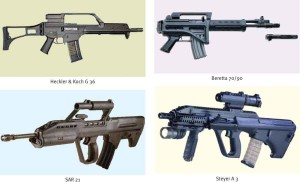 Bureaucratic red tape continues to be the main hurdle in modernising the infantry. One reason also is that such deals are considered small compared to bigger weapon systems and evoke little interest because of the money involved and consequential smaller cuts (read bribes), which is a fact linked with every defence deal, no matter the denials by the Ministry of Defence (MoD). The Central Armed Police Forces (CAPF), who do not have the luxury of larger weapon systems and consequently do not need comparisons, are going ahead with modernisation plans. The CRPF personal armed with the Israeli X-95 carbines are visible on duty in Jammu and Kashmir. The BSF has already signed a contract with Italy’s Beretta for buying 68,000 submachine guns worth over Rs 400 crore.
Bureaucratic red tape continues to be the main hurdle in modernising the infantry. One reason also is that such deals are considered small compared to bigger weapon systems and evoke little interest because of the money involved and consequential smaller cuts (read bribes), which is a fact linked with every defence deal, no matter the denials by the Ministry of Defence (MoD). The Central Armed Police Forces (CAPF), who do not have the luxury of larger weapon systems and consequently do not need comparisons, are going ahead with modernisation plans. The CRPF personal armed with the Israeli X-95 carbines are visible on duty in Jammu and Kashmir. The BSF has already signed a contract with Italy’s Beretta for buying 68,000 submachine guns worth over Rs 400 crore.
Earlier, the CRPF had signed an order for the purchase of 12,000 X-95 Tavor carbines from Israel costing over Rs 1 lakh apiece. Force One of the Maharashtra Police created post 26/11, has been armed with the Colt M-4 carbines from the US, Brugger and Thomet submachine guns from Switzerland, MP-5 submachine guns from Germany and AK-47variants from eastern Europe.
Bureaucratic red tape continues to be the main hurdle in modernising the infantry…
The Future Infantry Soldier System (F-INSAS) program, which is to ensure a dramatic increase in lethality, survivability and mobility while making the infantry soldier “a self-contained fighting machine”, is based on the Land Warrior system of the US Army and Future Soldier Programs of other nations. Most of the equipment is being indigenously developed by DRDO as the prime developer and the systems integrator, as well as with private partnerships. The F-INSAS is being developed in three phases. Phase I (originally scheduled to be completed by 2012) comprising Weapons, Body Armour, Clothing and Individual equipment; Phase II is the Target Acquisition System and Phase III will comprise the Computer Sub System, Radio Sub System, Software and Software Integration.
The F-INSAS will aim to provide the infantryman with the latest weaponry, communication network and instant access to information on the battlefield. It will include a fully networked all-terrain, all-weather personal-equipment platform, enhanced firepower and mobility for the digitalised battlefield of the future. The infantryman will be equipped with mission-oriented equipment integrated with his buddy soldier team, the sub-unit, as also the overall Command, Control, Communications Computers, Information and Intelligence (C4I2) system. Complete fielding in all infantry and RR units (some 465 battalions) is planned to be completed by 2020 or so but going by past DRDO record, it may well be delayed by another five years.
The core systems of the F-INSAS comprise helmet and visor, clothing, weapons and accessories. The helmet is an integrated assembly equipped with helmet mounted flash light, thermal sensors and night vision devices, digital compass, video cameras, computer and nuclear, chemical and biological sensors with audio headsets. The visor is intended to be integrated and to act as a head-up display monitor equivalent to two 17-inch computer monitors. The personal clothing of the infantry soldier of the future would be lightweight with a bullet-proof jacket. The futuristic jacket would be waterproof yet breathable. The new attire will enable the troops to carry extra load and resist the impact of nuclear, chemical and biological warfare.
The uniform will also carry solar chargers for palmtops and other attached electronic equipment. It will contain external oxygen supply and respirator providing protection against gas and smoke and will include flame retardant carbonised viscose undergarments, fire-proof knee and elbow pads, bullet-proof armoured waistcoat designed to stop a bullet, ceramic armour plates covering the front, back and groin and an armoured helmet capable of stopping a 9mm round at close range. The new uniform will have vests with sensors to monitor the soldier’s health parameters and provide quick medical relief.
The Battlefield Management System (BMS) and F-INSAS programs are being developed concurrently…
The weapons sub-system is being built around a multi-caliber individual weapons system with the fourth caliber attached to a grenade launcher. These include a 5.56 mm, a 7.62 mm and a new 6.8 mm under development for the first time in India. The Under Barrel Grenade Launcher (UBGL) will be capable of launching air bursting grenades. The sub-system includes a thermal weapon sight and laser range finder to provide the soldier with range and direction information.
The Global Positioning System (GPS) location information will allow the soldier to call for indirect fire accurately. Assault rifles and carbines are being imported, as mentioned above. As for accessories, soldiers will be equipped with Palmtop GPS device for communicating with other soldiers and locate or generate maps to find location and for situational awareness. The palmtop will inform the soldiers of the location of friendly forces in relation to their own positions. It will also enable them to transfer messages. Terrain equipment gears for various specific missions will also be carried. Thermal imaging, sensors and night vision equipment will be customised to make them portable. Advanced GPS receivers, infra-red sensors, thermal sensors, electro-magnetic sensors and radio frequency sensors would also be carried.
The Battlefield Management System (BMS) and F-INSAS programs are being developed concurrently; the BMS under Information Systems and F-INSAS under the Infantry. The BMS was conceived at battalion/regiment level pan army (including for the infantry) and comprises communication, non-communication hardware and software. The lowest level to which the system will be connected is the individual soldier/weapons platform and the highest level with the Battalion/Regiment Commander. The system will be further integrated with the Tactical Command, Control, Communications and Information (TAC C3I) System through the Command Information Decision Support System (CIDSS). The Directorate General of Information System (DGIS) is charged with facilitating transformation of the IA into a dynamic network-centric force, achieving information superiority through effective management of information technology.
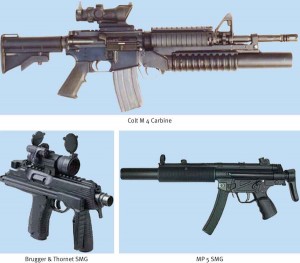 Quite logically, Phase III of the F-INSAS (Computer Sub System, Radio Sub System, Software and Software Integration) should have been part of the BMS, especially since the latter also caters for Mechanised Infantry both in mounted and dismounted roles. Squabbling over delimitation between the BMS and F-INSAS cost delays to Phase I of BMS by almost one year. Since F-INSAS is to incorporate situational awareness and GIS, it amounts to not only ‘re-inventing the wheel’ but will require yet another project to integrate the F-INSAS with the BMS implying infructuous and avoidable additional expenditure and time.
Quite logically, Phase III of the F-INSAS (Computer Sub System, Radio Sub System, Software and Software Integration) should have been part of the BMS, especially since the latter also caters for Mechanised Infantry both in mounted and dismounted roles. Squabbling over delimitation between the BMS and F-INSAS cost delays to Phase I of BMS by almost one year. Since F-INSAS is to incorporate situational awareness and GIS, it amounts to not only ‘re-inventing the wheel’ but will require yet another project to integrate the F-INSAS with the BMS implying infructuous and avoidable additional expenditure and time.
Why the Army and CAPF are resorting to imports is simply because the indigenous weapons are sub-standard; a situation where the terrorists and insurgents have better arms is unacceptable. That we are unable to produce state-of-the-art individual small arms should be a matter of shame for the DRDO, Ordnance Factories Board (OFB) and the MoD under whom both these bodies are directly placed, as also the Defence Minister as one of the longest serving Defence Ministers. Ironically, the MoD has failed to usher in accountability into these organisations and they continue to remain lackadaisical in meeting the demands of national security despite the crores consumed annually by these establishments.
The Government must sincerely overhaul the DRDO, OFB and the PSUs by bringing in accountability…
Requirements
The Government must sincerely overhaul the DRDO, OFB and the PSUs by bringing in accountability and making them more focused. Clear directions must be given about what is required to be done laying down strict timelines. A system of roll on development, monitoring, periodic checks, feedback and mid-course corrections is needed. A Weapons, Equipment and Technology Development Roadmap on a 15 to 20 year basis is required and appropriate R&D allocations are warranted. This must include specific measures for leapfrogging technology and should be made known to indigenous private industry well in advance. Although dialogue between MoD, Military and DRDO-OFB-PSUs is institutionalised, same is not the case between the MoD-Private Industry-users (Military). Open and periodic dialogue between MoD-Private Industry-users (Military) is essential to ascertain why the Private Industry is resentful of the existing framework and DPP.
The annual review of the DPP must incorporate Private Industry participation in the review process itself. Having intimated the Weapons, Equipment and Technology Development Roadmap to the Private Industry well in advance, a feedback must be instituted (perhaps through organisations such as the CII and ASSOCHAM) to ascertain which Private Industry or Conglomerate of Private Industries are prepared to take on weapons, equipment and/or technology. Considering the load of the DRDO-OFB-PSUs, the Government should actually bifurcate the products to be developed by the private sector and by the PSUs. Banning firms on the first accusation of corruption without alternative sources of procurement is a recipe of disaster that kills modernisation plans. While action against the corrupt is warranted outright banning of firms forces the military to make do with archaic weapons.
Prudence demands that we look beyond the F-INSAS and modernisation of the infantry…
Looking Beyond
Prudence demands that we look beyond the F-INSAS and modernisation of the infantry. Soldiers other than from Infantry also contribute to the ‘cutting edge’ as frontline troops. The BMS is catering for the digitised battlefield at regiment/battalion level pan army but the BMS does not cater for improvements in Weapons, Body Armour, Clothing and Individual equipment, which actually should be part of soldier modernisation pan army. In an environment of counter terrorism and counter insurgency, invariably troops other than infantry also get involved in operations inadvertently or advertently. We should therefore be looking at across-the-board soldier modernisation concurrent to the infantry soldier.
A dispassionate analysis would indicate that the costs involved are miniscule compared to big ticket acquisitions and a minor curtailing of the latter can easily be adjusted against full spectrum soldier modernisation considering the pay offs in terms of enhanced operational efficiency at the cutting edge. Such modernisation should include very basic items for NBC protection such as masks, gloves and helmets.
Considering the heightened unconventional threats that are likely to expand in future, the entire Security Sector needs to be energised. The national cutting edge includes the Para Military Forces (PMF) and CAPF besides others. Therefore, at least those PMF and CAPF units that are engaged or tasked for counter terrorism and counter insurgency must be part of soldier modernisation. In twenty-first century conflict situations not only will operations call for increased inter-agency cooperation but will also involve greater application of ‘all elements of national power’ as our adversaries will employ hi-tech irregular forces against us. If we can achieve soldier modernisation within the Security Sector and network this cutting edge at the national level, we can be sure to win future conflicts.
Conclusion
Infantry modernisation has not received due importance in past decades. This must be treated as an ‘emergent’ requirement in consideration of the emerging threats from within and outside the country and against the backdrop of the level of sophistication being achieved by terrorists and insurgents. India must be prepared for short, intense hi-tech wars, in addition to expanding terrorism, asymmetric and fourth generation wars where the soldier faces the brunt at the cutting edge. Delay in modernisation has a direct bearing on combat efficiency in coping with threats to national security and may cost the lives of the infantrymen.




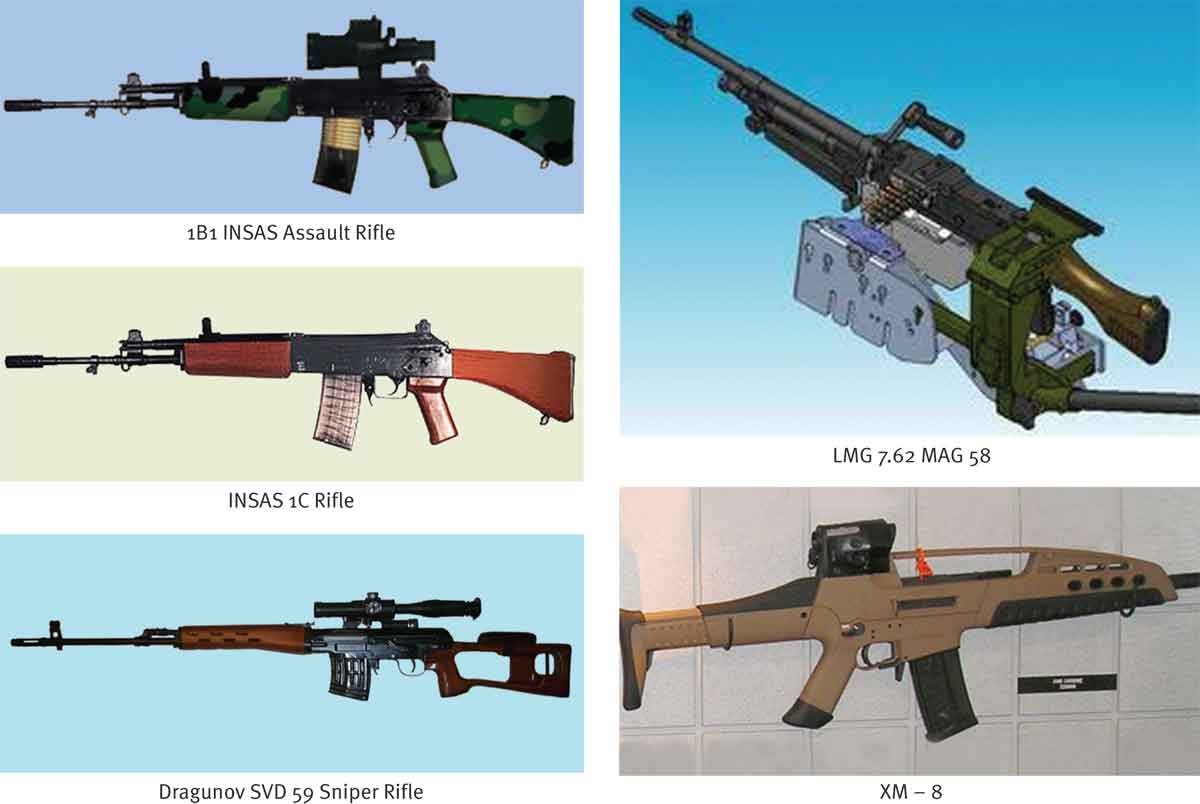
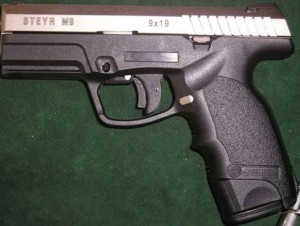

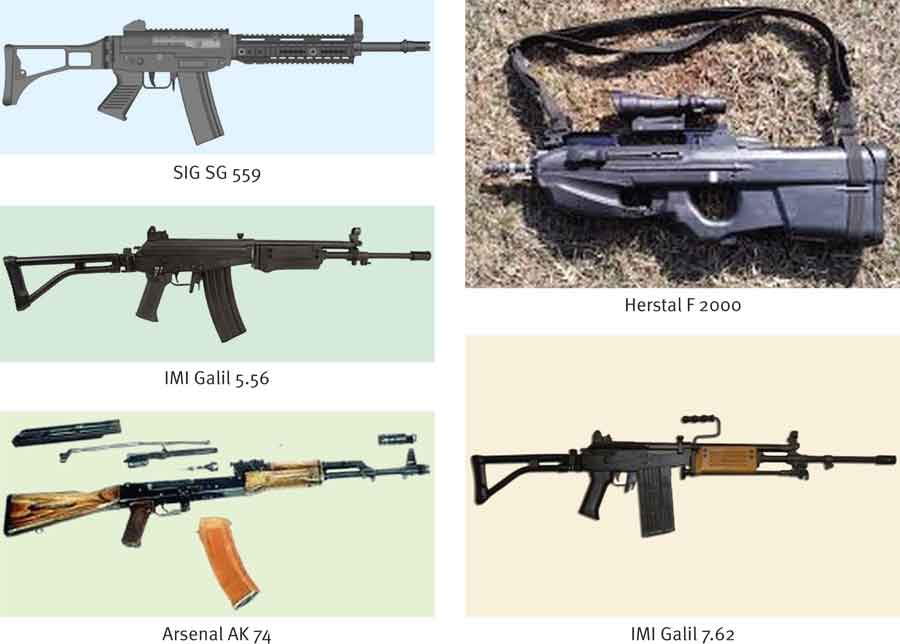
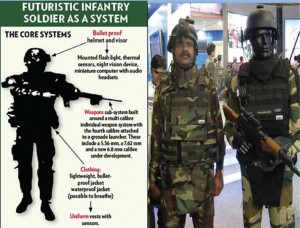

Most modern infantry with latest weapons to fight who?
China & Pakistan are not the most modern equipped armies. They are even below in equipment compared to India. Their weapon is intimidation with nuclear weapons (Pakistan), better infrastructure in Tibet (China).
You have not made a good point to explain why only 60,000 new rifles to be imported and 100,000 to be made locally. You out of the people know that India has 1.1 million people under arms. You need that many rifles if the existing INSAS has to be replaced. Where are the remaining 900,000 rifles going to come from.
You general out of all the people know that FAL (Ishapore) was a great rifle. It kicked like a mule at 600 to 800 yards. It was big mistake to switch to smaller caliber 5.56 rifle. Excuse given was that a soldier will carry more ammunition in his back pack. How much more – to last another 20 minutes in a long battle. The point here is that a soldier has to be resupplied. The 7.62 or 5.56 does not better. Under the circumstances, If I am soldier I would like to carry 7.62 to kill the enemy in the first shot.
As a matter of fact the generals of 80s & 90s were listening too much of American propaganda. They were switching to M-16 with smaller bullets which inhumanely kills at 400 yards. It does not penetrate but turns inside the body tearing the organs apart. The 7.62 passes thru a man and the next one and kills instantly.
Now the generals of today have realized their great folly (asking for INSAS 5.56mm) and are correcting themselves now by asking for interchangeable barrel. It hides their past mistakes and corrects the problem of range and velocity in the smaller bullet. What an expensive disaster got perpetuated in 90s when smaller bullet 5.56 mm was introduced. Correction is coming now. The generals are asking for bigger barrel and bullet.
incidentally do not listen too much to the Americans. In last 30 years, they fight only close quarter battlers where 5.56 is good. India is different